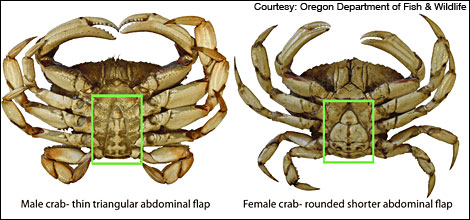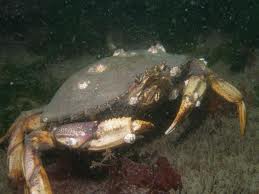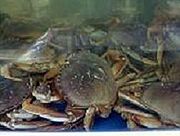Dungeonous crab
From marinelife1011
Metacarcinus magister is a member of the subphylum Crustacea and was formally known as Cancer magister. Commonly referred to as the Dungeness crab, it inhabits the shallow ocean floors of western North America, and is usually found in sandy and muddy-bottom substrates (Juanes and Hartwick, 1990). The Dungeness crab was named after a small town and the shallow bay inside of Dungeness Spit on the Olympic Peninsula in Washington State [1]. There is a supreme fisheries market for this crustacean and it is heavily consumed by people on the west coast.
| Dungeness Crab | |
|---|---|
 |
|
| Metacarcinus magister | |
| Scientific classification | |
| Kingdom: | Animalia |
| Phylum: | Arthropoda |
| Subphylum: | Crustacea |
| Class: | Malacostraca |
| Order: | Decapoda |
| Family: | Cancridae |
| Genus: | Metacarcinus |
| Species: | M. magister |
| Binomial name | |
| Metacarcinus magister (Dana, 1852) |
|
Contents |
Description
Morphology
M. magister is a decapod crustacean that exhibits sexual dimorphism [[2]] with the females being smaller than males, which are 7 inches across the back compared to the females at just 6 inches. The largest size attainable by this crab is up to 9 inches across the back, which makes M. magister one of the largest edible crabs along the pacific coast. Their size is the easiest way to distinguish M. magister from other crabs found in the same area. The carapace is broadly oval and is approximately 2/3 as long as it is wide [3]. Their color ranges from a reddish brown to brown with a purple wash.
Distribution
M. magister is found from Alaska to southern California and generally inhabits coastal waters up to 100 feet of depth. They are benthic and prefer eel grass, muddy, and sandy bottoms (Juanes and Hartwick, 1990) [4].
Reproduction
With M. magister reproduction takes place between the hard-shelled males and the recently-molted females during the late spring and summer. The males have been found to have "mating marks", which are abrasions found on the inner surfaces of their chelipeds; these marks are caused by contact from the pre-mating embrace, and can help determine exo-skeleton age in males by examining the marks for previous breeding and molting evidence (Juanes et al, 1990). The males are polygamous, which means they mate with more than one female crab [5]. The males use pheromones to locate the female crabs and can remain with his mate up to two days after copulation to ensure her protection [6].Females store the fertilized eggs for several months under their abdomen until the eggs hatch (between February and April). Large females can carry more than 2.5 million eggs. For the first 90-120 days after hatching, Dungeness crabs are free-floating planktonic larvae. Larvae settle down onto the bottom of an estuary or near-shore environment between June and September, where they molt into recognizable crabs. Crabs can molt as many as ten times in their first year [7]. After molting into the last larval stage, or megalopae, the crabs settle and enter estuaries in high number which suggest that the estuaries act as a nursery to the juvenille crabs (Fernandez et al, 1993).
Ecology and Behavior
M. magister is both a predator and prey for some other marine organisms. They feed on fish, shrimp, and clams and are a food source for fish (e.g. halibut, dogfish, hake, lingcod) and octopus. Crabs will also eat other crabs [8]. It is hypothesized that M. magister uses two antenulles acting as receptors in a chemosensory system to locate food (Pearson et al., 1979) M. magister uses its pinchers and hard shell for defense. The dungeness crab can only grow through shedding of its shell (molting), but once the shell has hardened the crab cannot grow to a larger size.The crab will first begin to grow a soft shell and then backs out of its hard shell through a crack. Shedding the hard shell takes about 15 minutes, but it takes approximately two months for the newly developed soft shell to harden. During this period, the crabs are vulnerable to predators and tend to hide in the sand or mud. The crab’s newly formed shell is usually 11-29% bigger than the previous shell. A mature crab molts about once a year [9].
Economic Value and Fishery Sustainability
Oregon is the world’s top producer of Dungeness crab, with the state’s fleet of 425 boats fishes with pots about 10 miles off the coast from December through August. By choosing the season and fishing only larger males, the fleet has ensured a steady supply of crab since the 1800s. The first reported commercial landing of Dungeness crab in Oregon was in 1880 and was 6,628 pounds worth (Waldron, 1958). The fishery is now worth nearly $45 million in landed crab value [10].
References
Prey Size Selection in Dungeness Crabs: The Effect of Claw Damage Francis Juanes and E. B. Hartwick Ecology Vol. 71, No. 2 (Apr., 1990), pp. 744-758
Habitat selction by young-of-the-year Dungenss crab Cancer magister and predation risk in intertidal habitats Miriam Hernandez, Oscar Iribarne, and David Armstrong Marine Ecology Progress Series Vol.92. 171-177, 1993
Thresholds for Detection and feeding behavior In The Dungeness Crab Cancer magister (Dana) Walter H. Pearson, Peter C. Sugarman, and Dana L. Woodruff J. exp. mar. bio. Ecology.,1979,Vol. 39, pp.65-78
The fishery and Biology of the Dungeness Crab (Cancer magister Dana) in Oregon Waters Kenneth D. Waldron. Fish Commission of Oregon.,Contribution No. 24, May, 1958
1. http://www.netartsbaytoday.org/html/dungeness_crab.html
2. http://en.wikipedia.org/wiki/Sexual_dimorphism
3. http://www.fao.org/fishery/species/3461/en
4. http://www.whatcom-mrc.whatcomcounty.org/Fact_Sheets/dungeness_crab.htm
5. http://www.psmfc.org/habitat/edu_crab_fact.html
6. http://ecotrope.opb.org/2010/12/dungeness-crab-now-certified-sustainable/





